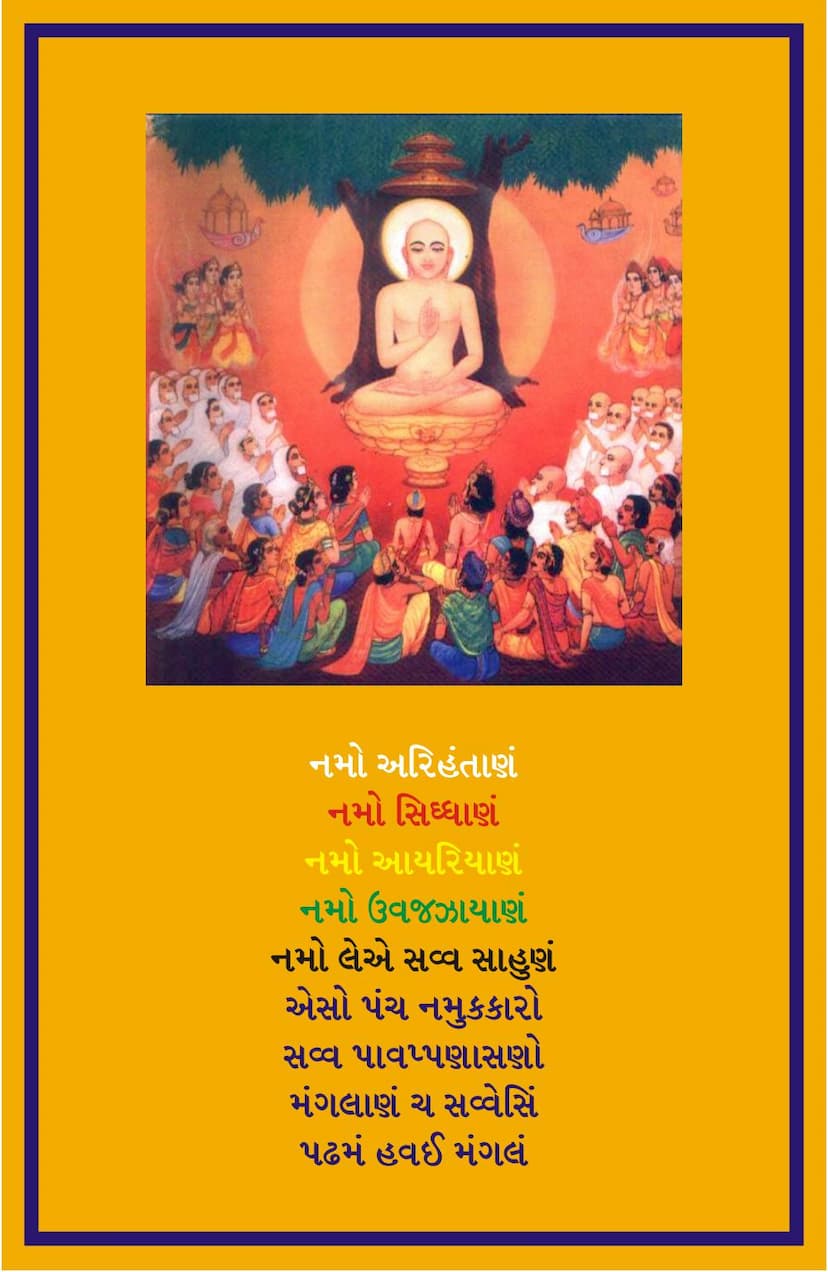Agam 06 Ang 06 Gnatadharma Sutra Part 01 Sthanakvasi Gujarati
Added to library: September 1, 2025

Summary
Certainly! Here's a comprehensive summary in English of the provided Jain text, "Agam 06 Ang 06 Gnatadharma Sutra Part 01 Sthanakvasi Gujarati," authored by Ghasilal Maharaj and published by A B Shwetambar Sthanakvasi Jain Shastroddhar Samiti.
This text is the first part of the sixth Anga (limb) of the Jain Agamas, the Gnatadharma Sutra, presented in Gujarati. It is accompanied by a commentary named "Angaradharmamrutavarshini" by Acharya Ghasilalji Maharaj and translated into Hindi and Gujarati.
The text begins with a standard Jain invocation: "Namo Arihantanam, Namo Siddhanam, Namo Ayariyanam, Namo Uvajjhayanam, Namo Loe Savva Sadhunam. Easo Panch Namukkaro Savva Pavappanasano, Mangalanam Cha Savesim Padhamam Havai Mangalam." This is the Pancha Namaskara Mantra, considered the most auspicious, capable of destroying all sins and the foremost of all auspicious chants.
The introductory pages also highlight the "Jain Agam Prakashan Yojana" (Jain Agama Publication Scheme) by Acharya Ghasilalji Maharaj, with Shri Chandra P. Doshi as the organizer.
Core Content Summary:
The Gnatadharma Sutra, as presented in this part, is a Dharma Kathanuyog (Discourse on Dharma through Stories). It focuses on explaining the principles of Jainism through narratives and illustrative examples. The core purpose is to guide beings towards the path of liberation by detailing the nature of dharma, the consequences of actions (karma), and the path of renunciation.
The text delves into various aspects of Jain teachings, often through the lens of the life and teachings of Lord Mahavir and his disciples, particularly Sudharma Swami, who is depicted as a prominent disciple of Lord Mahavir. The narratives often involve kings, queens, merchants, and even animals, illustrating moral and ethical principles.
Key Themes and Elements Found in the Text:
- The Nature of Dharma: Dharma is explained as that which steers beings away from suffering and towards auspicious states of existence. It is embodied in principles like Ahimsa (non-violence), compassion, charity, and forgiveness.
- Karma and its Consequences: The sutra emphasizes that individuals experience the results of their own good and bad deeds. The narratives illustrate how actions in this life and past lives influence future destinies.
- The Teachings of Lord Mahavir and His Disciples: The sutra presents dialogues, questions and answers, and sermons delivered by Lord Mahavir and his chief disciple, Sudharma Swami. These discussions often clarify complex Jain philosophical concepts.
- Illustrative Narratives (Aakhyayikas): A significant portion of the sutra consists of stories (aakhyayikas) that serve as allegories and examples to explain Jain principles. These stories often highlight the importance of ethical conduct, the pitfalls of desires and attachments, and the path to spiritual liberation. Examples include:
- Meghakumar's Story: A substantial part of the text is dedicated to the life and experiences of Meghakumar, tracing his journey from his birth, his royal upbringing, his longing for spiritual liberation, his encounter with Lord Mahavir, and his eventual renunciation and attainment of spiritual perfection. This narrative illustrates the transient nature of worldly pleasures and the ultimate importance of spiritual pursuit.
- Dhanishreshthi and Vijay the Thief: This story highlights the consequences of attachment to wealth and the destructive nature of greed.
- King Shrenik and Queen Dharini: Their interactions, including Dharini's dreams and their interpretations, offer insights into the spiritual significance of events and the king's devotion to dharma.
- The Peacock and its Eggs (Mayur Ke And): This likely serves as an allegory for understanding, nurturing, or the importance of protecting the vulnerable.
- The Story of Vijaydutt and Sagardatt: This narrative might explore themes of friendship, rivalry, or the consequences of certain actions.
- The Story of the Crane and the Jackals: This story likely illustrates themes of wisdom, caution, or the consequences of foolishness.
- The Story of the Tortoise: This may be an allegory for patience, steadfastness, or the importance of protecting oneself.
- The Role of Acharyas and Monks: The text showcases the wisdom and conduct of Jain monks and spiritual leaders like Sudharma Swami and Meghakumara (after his renunciation), demonstrating the path of asceticism and spiritual discipline.
- The Importance of Right Conduct: The narratives consistently underscore the necessity of righteous actions, ethical behavior, and adherence to Jain vows and principles.
- Guidance on Swadhyaya (Self-Study): The text provides specific instructions on the appropriate times and conditions for studying the sutra, including periods of "Aswadhyaya" (times when study is prohibited) due to natural phenomena (like meteor showers, fires, storms) or specific bodily states. This emphasizes the reverence and discipline required in spiritual study.
Overall Significance:
The Gnatadharma Sutra, particularly this part, serves as a comprehensive guide for spiritual aspirants. It uses engaging stories to make profound philosophical and ethical principles accessible. By illustrating the consequences of actions and the rewards of spiritual discipline, it aims to inspire virtuous living and guide individuals towards the ultimate goal of liberation (moksha). The commentary by Acharya Ghasilalji Maharaj further elucidates these teachings, making them comprehensible for the contemporary reader. The emphasis on proper conduct, moral uprightness, and the pursuit of knowledge is central to the message of the sutra.